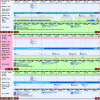Human MHC architecture and evolution: implications for disease association studies
- PMID: 18397301
- PMCID: PMC2408657
- DOI: 10.1111/j.1744-313X.2008.00765.x
Human MHC architecture and evolution: implications for disease association studies
Abstract
Major histocompatibility complex (MHC) variation is a key determinant of susceptibility and resistance to a large number of infectious, autoimmune and other diseases. Identification of the MHC variants conferring susceptibility to disease is problematic, due to high levels of variation and linkage disequilibrium. Recent cataloguing and analysis of variation over the complete MHC has facilitated localization of susceptibility loci for autoimmune diseases, and provided insight into the MHC's evolution. This review considers how the unusual genetic characteristics of the MHC impact on strategies to identify variants causing, or contributing to, disease phenotypes. It also considers the MHC in relation to novel mechanisms influencing gene function and regulation, such as epistasis, epigenetics and microRNAs. These developments, along with recent technological advances, shed light on genetic association in complex disease.
Figures







References
-
- Aitman TJ, Dong R, Vyse TJ, Norsworthy PJ, Johnson MD, Smith J, et al. Copy number polymorphism in Fcgr3 predisposes to glomerulonephritis in rats and humans. Nature. 2006;439:851. - PubMed
-
- Apanius V, Penn D, Slev PR, Ruff LR, Potts WK. The nature of selection on the major histocompatibility complex. Critical Reviews in Immunology. 1997;17:179. - PubMed
-
- de Bakker PI, Burtt NP, Graham RR, Guiducci C, Yelensky R, Drake JA, et al. Transferability of tag SNPs in genetic association studies in multiple populations. Nature Genetics. 2006a;38:1298. - PubMed
Publication types
MeSH terms
Substances
Grants and funding
LinkOut - more resources
Full Text Sources
Other Literature Sources
Research Materials

